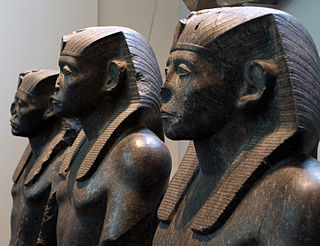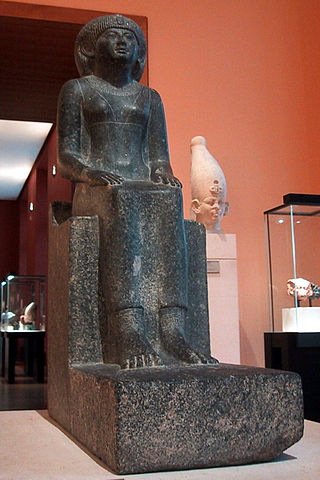Related Research Articles

Amenemhat III, also known as Amenemhet III, was a pharaoh of ancient Egypt and the sixth king of the Twelfth Dynasty of the Middle Kingdom. He was elevated to throne as co-regent by his father Senusret III, with whom he shared the throne as the active king for twenty years. During his reign, Egypt attained its cultural and economic zenith of the Middle Kingdom.

Dahshur is a royal necropolis located in the desert on the west bank of the Nile approximately 40 kilometres (25 mi) south of Cairo. It is known chiefly for several pyramids, two of which are among the oldest, largest and best preserved in Egypt, built from 2613 to 2589 BC.

Nubkaure Amenemhat II, also known as Amenemhet II, was the third pharaoh of the 12th Dynasty of ancient Egypt. Although he ruled for at least 35 years, his reign is rather obscure, as well as his family relationships.

Khakaure Senusret III was a pharaoh of Egypt. He ruled from 1878 BC to 1839 BC during a time of great power and prosperity, and was the fifth king of the Twelfth Dynasty of the Middle Kingdom. He was a great pharaoh of the Twelfth Dynasty and is considered to be, perhaps, the most powerful Egyptian ruler of the dynasty. Consequently, he is regarded as one of the sources for the legend about Sesostris. His military campaigns gave rise to an era of peace and economic prosperity that reduced the power of regional rulers and led to a revival in craftwork, trade, and urban development. Senusret III was among the few Egyptian kings who were deified and honored with a cult during their own lifetime.

Hor Awibre was an Egyptian pharaoh of the 13th Dynasty reigning from c. 1777 BC until 1775 BC or for a few months, c. 1760 BC or c. 1732 BC, during the Second Intermediate Period. Hor is known primarily thanks to his nearly intact tomb discovered in 1894 and the rare life-size wooden statue of the king's Ka it housed.

Khnumhotep III was an ancient Egyptian high steward and vizier of the 12th Dynasty.
Neferthenut was an ancient Egyptian queen of the Twelfth Dynasty of Egypt. She was most likely the wife of Senusret III.
Nubhetepti-khered was an ancient Egyptian king's daughter of the Thirteenth Dynasty. She is basically only known from her undisturbed burial at Dahshur which was discovered in 1894 by Jacques de Morgan, close to the pyramid of Amenemhat III.

Khenemetneferhedjet I Weret was an ancient Egyptian queen of the 12th Dynasty, a wife of Senusret II and the mother of Senusret III.

Siese was a vizier and treasurer of the Twelfth Dynasty of Egypt. He was most likely in office under Senusret III.
Nebit was an ancient Egyptian official during the reign of king Senusret III. He held the position of vizier. Thus, he was the most important official at the royal court. Nebit is only known from his large mastaba, which was excavated next to the pyramid of the king at Dahshur. The mastaba was built of mud bricks and then covered with stones. Already in ancient times the high quality stone was looted and used for other building projects or just for burning lime. However, one wall of the mastaba facade had already collapsed and had been covered by sand before looters dismantled the rest of the building. The preserved facade bears the name and title of Nebit, but also the name of the king. Within the remains of the mastaba were found by Jacques de Morgan the bust of a statue made of granodiorite. The fragment is not inscribed but most likely depicts Nebit.

Sithathor was an ancient Egyptian princess with the title king's daughter. She is only known from her burial at Dahshur. Next to the pyramid of king Senusret III were found underground galleries as a burial place for royal women. Most of the burials were found looted, but there were two boxes for jewellery overlooked by tomb robbers. Both boxes contained an outstanding collection of jewellery. They were called the first and the second treasure of Dahshur. The first treasure was discovered on 6 March 1894 and belonged most likely once to Sithathor. Several scarabs with her name were found. The treasure contained a pectoral with the names of king Senusret II, one of the masterpieces of Egyptian goldwork. Other objects were golden shells, golden bracelets, a mirror and several stone vases. Sithathor is not known for sure outside her tomb. She was perhaps a daughter of Senusret III, but it is also possible that she was the daughter of Senusret II and buried as sister of king Senusret III next to him.

Itakayt was an ancient Egyptian princess and queen of the 12th Dynasty, around 1800 BC. She is mainly known from her small pyramid next to the one of Senusret III at Dahshur. She had the titles king's daughter of his body, powerful, graceful and beloved.
Menet was an ancient Egyptian king's daughter living in the Twelfth Dynasty most likely under the kings Senusret III and Amenemhat III. Menet had the titles king's daughter and the one united with the white crown (Khenemetneferhedjet). She is only known from her sarcophagus and burial in a gallery tomb buried with other members of the royal family next to the pyramid of Senusret III at Dahshur. From the position of the tomb it seems likely that she was the daughter of the latter king.

The pyramid of Senusret III is an ancient Egyptian pyramid located at Dahshur and built for pharaoh Senusret III of the 12th Dynasty.
Hathorhotep was an ancient Egyptian king's daughter at the end of the Twelfth Dynasty during the Middle Kingdom.

Mereret was an Ancient Egyptian King's Daughter known from her burial next to the Pyramid of Pharaoh Senusret III at Dahshur. On the north side of the king's pyramid was a row of four pyramids belonging to the king's wives. These pyramids were connected by an underground gallery. On the west side of the gallery were further burials arranged for women with the title king's daughter. They were buried in sarcophagi that were placed into niches. All burials were found looted. However, the robbers missed two boxes filled with personal adornments found in 1894 by Jacques de Morgan. One of these boxes must have belonged to a king's daughter Sithathor, the other box to a king's daughter with the name Mereret or Meret.

Khenmet was an ancient Egyptian king's daughter of the Twelfth Dynasty, around 1800 BC. She is mainly known from her unrobbed tomb containing a set of outstanding personal adornments.

Itaweret was an Ancient Egyptian king's daughter who lived in the 12th Dynasty around 1850 BC. She is known from her burial next to the pyramid of king Amenemhat II at Dahshur. The burial was found intact and contained a decorated wooden coffin and canopic box with longer religious texts including her name. Some personal adornments were found in the tomb too. The location of the tomb might indicate that she was a daughter of Amenemhat II, but a final proof is missing. Remarkable is the wooden statue of a swan found in her burial apartments.

The Dahshur boats are a group of ancient Egyptian funeral boats, originally numbering five or six, discovered near the funerary complex of the 12th Dynasty pharaoh Senusret III.
References
- ↑ Jacques de Morgan: Fouilles a Dahchour, Mars-Juin 1894. Vienna 1895, p. 56
- ↑ Dieter Arnold: The Pyramid Complex of Senwosret III at Dahshur, Architectural Studies, New York 2002 ISBN 0-87099-956-7, 71-72, pls. 84a, 111-112, 119